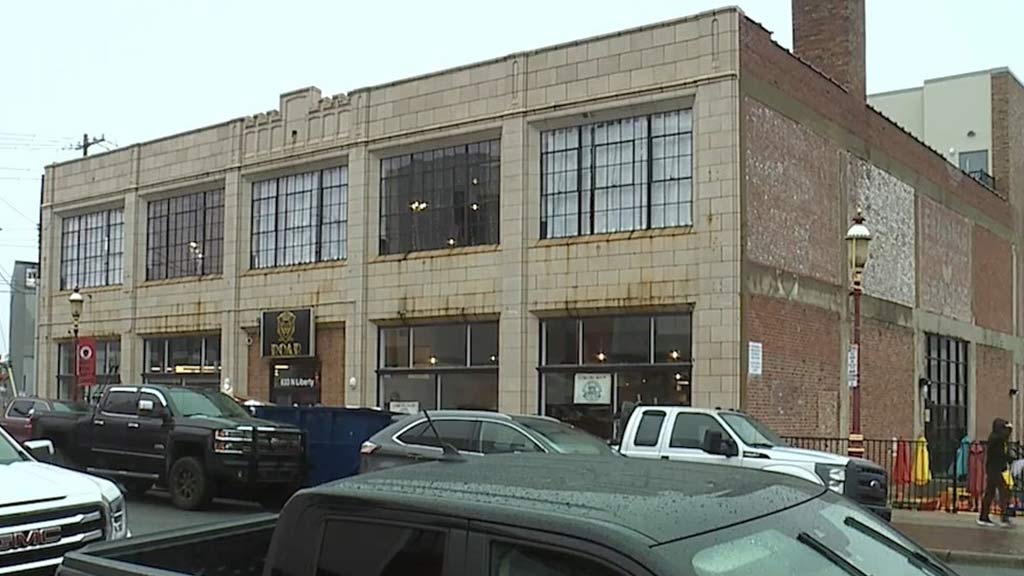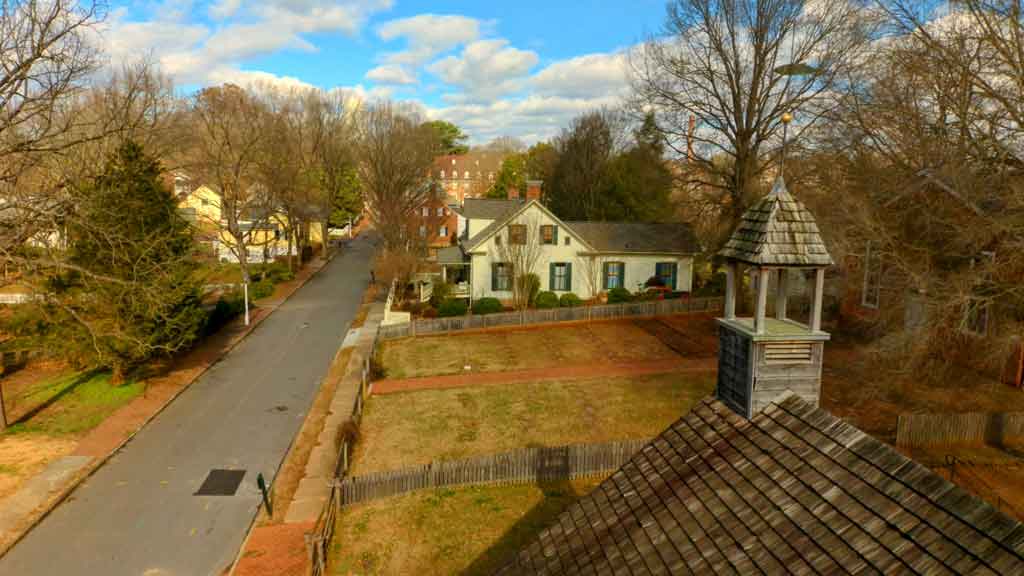Step back in time and immerse yourself in the rich history of Salem, North Carolina. Originally settled by the Moravian community in 1766, this historic district of Winston-Salem, United States, is a living history museum that offers a glimpse into the past.
Declared a National Historic Landmark in 1966, Old Salem showcases the culture and heritage of the Moravian settlement during the 18th and 19th centuries.
Explore the communal buildings, churches, houses, and shops that paint a vivid picture of life in the Province of North Carolina.
As you wander through the cobblestone streets, you’ll feel the essence of colonial America and post-statehood eras come to life.
The meticulous restoration efforts by the nonprofit organization since 1950 have preserved this heritage for generations to come. Get ready to embark on a journey through time in Salem, North Carolina.
Early History of Salem
The early history of Salem, Indiana, is characterized by the pioneering spirit of its settlers, the development of its economy, and the establishment of key institutions.
Here’s an overview:
The Moravian Settlement
Founded in 1772, Salem, North Carolina, was established as the central town of the Wachovia Tract. The Moravian Church meticulously planned, built, and operated the town, intending it to be the primary economic, religious, and administrative center of the area.
The Moravians purchased the 99,000-acre tract of land from Lord Granville in 1753 and began construction in 1766.
The town of Salem was designed to be a hub of trade and manufacturing, with surrounding communities focused on agriculture.
The Construction of the Town

Construction on Salem began in 1766, though the Moravians had purchased the land in 1753. The Moravians decided to deviate from Count Nicholas von Zinzendorf’s circular town plans and instead opted for a grid layout.
Key town buildings like the Gemein Haus, Home Moravian Church, Single Brothers House, Single Sisters House, and the general store were strategically placed on the central square.
Salem’s architectural planning reflected the Moravian community’s focus on organization and communal living. The town’s structure and layout aimed to foster a sense of community while prioritizing efficiency and functionality.
Evolution of the Salem Community
The evolution of the Salem community in Indiana is a testament to resilience, adaptability, and community spirit.
Here’s how Salem’s community has evolved over time:
Role of the Church in Society
The Moravian Church played a pivotal role in shaping the Salem community, founded in 1772. As the central town of the Wachovia Tract, Salem was meticulously planned and constructed by the Moravians, aiming to establish it as an economic, religious, and administrative hub.
Buildings like the Gemein Haus and Home Moravian Church reflected the community’s emphasis on organization and communal living. The community’s dedication to communal living extended beyond architecture.
The Moravians implemented unique social structures and systems, such as the choir system, which grouped individuals based on age and marital status to foster a sense of belonging and support within Salem.
African American History in Salem
The history of African Americans in Salem is a significant part of the community’s evolution. Men from the Single Brothers choir in Old Salem were trained as tradesmen, contributing to the industrious pace of development.
This inclusive approach showcased the diverse and vibrant cultural tapestry of Salem, highlighting the contributions of African Americans to the growth and prosperity of the town.
These individuals played a crucial role in shaping Salem’s identity as a place of opportunity and equality, where skills and craftsmanship transcended racial boundaries. Their legacy continues to enrich the historical narrative of Salem, North Carolina.
Transformation into Winston-Salem

The transformation of Salem into Winston-Salem represents a merger of two historically significant towns in North Carolina, resulting in a dynamic and diverse urban center.
Here’s an overview of this transformation:
Economic and Social Factors
As Salem, North Carolina grew, its economic and social landscape underwent a significant transformation. The town’s evolution into Winston-Salem was marked by a shift towards industrialization and economic diversification.
With the establishment of tobacco and textiles industries, Winston-Salem emerged as a thriving urban center, attracting a diverse population seeking employment opportunities.
This shift not only bolstered the local economy but also fostered a sense of community and shared prosperity among residents.
The consolidation of Salem and Winston into Winston-Salem in 1913 brought about a merging of cultures and traditions, creating a vibrant tapestry of local heritage.
The blending of Moravian roots with the influences of newcomers from various backgrounds enriched the city’s cultural landscape, contributing to a dynamic and inclusive community.
Winston-Salem’s rich history reflects a harmonious fusion of traditions, shaping the city’s identity as a unique and welcoming destination.
Impact on Local Culture
The transformation of Salem into Winston-Salem had a profound impact on the local culture, giving rise to a dynamic interplay of traditions and customs.
The fusion of Moravian heritage with the influx of new industries and residents introduced a vibrant cultural exchange, shaping the city’s identity.
Winston-Salem’s diverse cultural scene, influenced by a blend of historical legacies and modern innovations, continues to thrive, offering a rich tapestry of arts, music, cuisine, and traditions.
The legacy of Salem’s communal living and inclusive approach to development laid the foundation for Winston-Salem’s cultural ethos of collaboration and creativity.
The city’s commitment to preserving its heritage while embracing new cultural influences has cultivated a vibrant arts community and a spirit of innovation.
Winston-Salem stands as a testament to the resilience and adaptability of its residents, who have embraced change while honoring the past, creating a dynamic and engaging cultural landscape.
Preservation of Salem’s Heritage
Preserving Salem’s heritage is essential for maintaining its cultural identity, historical significance, and sense of community pride.
Here are some key approaches to preserving Salem’s heritage:
Old Salem Museums and Gardens

Old Salem Museums and Gardens, commonly known as Old Salem, offers visitors a historically accurate recreation of Salem from 1766 to 1840.
With around 20 open buildings and gardens, you can explore the town’s rich history through costumed guides demonstrating trades such as metalworking, shoemaking, and pottery making.
As you wander the brick streets of the town, you’ll often hear the clomp clomp of horseshoes as horse-drawn carriages pass by.
Some of the buildings, like the Winkler Bakery and the T. Bagge Community Store, are accessible to the public without an admission ticket. At Winkler Bakery, you can savor traditional treats like sugar cake and Moravian Cookies.
If you’re looking for a souvenir crafted by Old Salem artisans, the T. Bagge Community Store is the perfect stop. Additionally, you can enjoy lunch and dinner at the historic Salem Tavern.
For more details on visiting Old Salem, including operating hours and admission fees, visit their official website at Old Salem Museums and Gardens.
Restoration and Conservation Efforts
The citizens of Salem have long been dedicated to preserving the historical heritage of their town. Initiatives like the Citizens Committee for the Preservation of Historic Salem were formed to conduct thorough studies of the structures in Old Salem.
Working alongside professional planners such as Russell Van Nest Black, these efforts culminated in the development of a comprehensive citywide zoning plan that encompassed the Old and Historic Salem District.
This zoning plan, implemented in 1948, included a prohibition on any new construction in the old area, signaling a strong commitment to conservation.
Additionally, various legislative measures such as the enactment of zoning laws have been put in place over the years to safeguard the architectural and historical integrity of Salem’s heritage.
As a result, Salem’s rich history and cultural significance have been meticulously preserved for future generations to appreciate and cherish.
Frequently Asked Questions
What is the history behind Salem, North Carolina?
Salem, North Carolina was founded in 1772 by the Moravian Church, evolving into Winston-Salem in 1913. The town’s history emphasizes economic, religious, and communal planning with a focus on contributions from African Americans.
How did Salem’s fusion of cultures enrich the city?
The fusion of cultures in Winston-Salem enhanced its cultural landscape, creating a sense of community and shared prosperity. The exchange of traditions led to a vibrant arts community and a spirit of innovation.
How is Salem’s heritage preserved?
The preservation efforts of Salem’s heritage are showcased through Old Salem Museums and Gardens, which recreates Salem from 1766 to 1840. Citizens’ commitment to conservation is evident in initiatives like the Citizens Committee for the Preservation of Historic Salem and citywide zoning plans.
Conclusion
You’ve delved into the rich tapestry of Salem, North Carolina’s history, witnessing its transformation from a Moravian settlement to the vibrant city of Winston-Salem.
The town’s economic, religious, and communal foundations have shaped a diverse and thriving community, where cultures converge to create a unique cultural identity.
Through preservation efforts and initiatives like Old Salem Museums and Gardens, the town’s heritage is meticulously conserved, ensuring that its architectural and historical legacy endures for generations to come.
Salem’s commitment to honoring its past while embracing innovation and progress is a testament to the resilience and spirit of its residents.
As you reflect on Salem’s journey, you appreciate the blend of tradition and modernity that defines this historic town.
Jaclyn Lowe